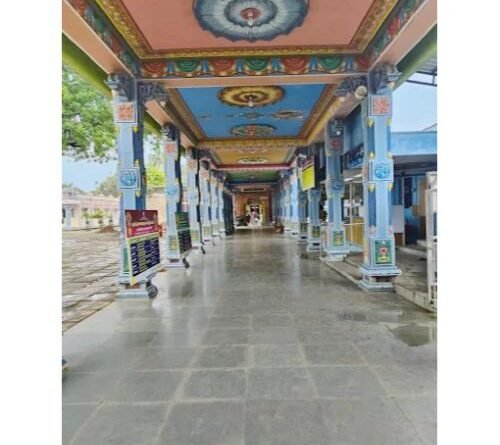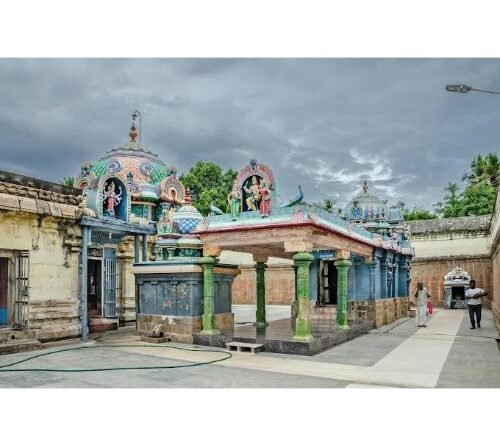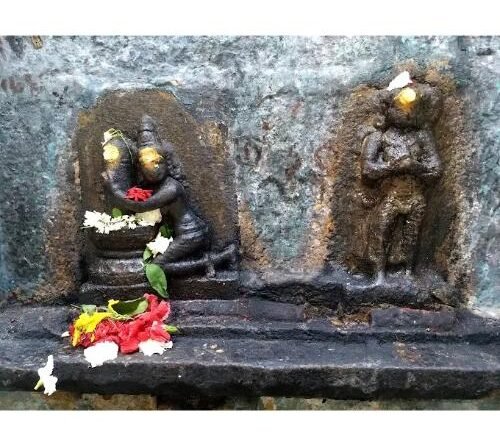Garbaratchambigai Temple Tirukkarugavur,Tamil Nadu
Garbharakshambigai Temple is a Hindu temple dedicated to Shiva located in Thirukarukavoor, Tamil Nadu, India. The temple is located 6 km (3.7 mi) east of Papanasam, 20 km (12 mi) south east of Kumbakonam, 10 km (6.2 mi) north of Saliyamangalam, 20 km (12 mi) north east of Thanjavur and on the southern bank of Vettar River.[2] Nearest railway station is Papanasam Railway Station, which is 5 kms away from Thirukarukavoor. Constructed in the Dravidian style of architecture, the temple is believed to have been built during the Cholas period in the 7th century. Shiva is worshipped as Mullaivananathar and his consort Parvathi as Garbharakshambigai.
The presiding deity is revered in the 7th-century Tamil Saiva canonical work, the Tevaram, written by Tamil saint poets known as the Nayanmars and classified as Paadal Petra Sthalam. A granite wall surrounds the temple, enclosing all its shrines. The temple has a five-tiered Rajagopuram, the gateway tower. The temple is located on the banks of the Vennaru River.
The temple is open from 6 am – 1 pm and 4 pm – 8:00 pm on all days. Six daily rituals and three yearly festivals are held at the temple, of which the Vaikasi Visagam for Mullaivananathar, Adipooram and Navarathri uthsavam for Ambal, Annabishekam, Kanthasashti, Karthigai Mahadeepam, Karthigai Sunday theerthavari and Panguni Uthram are some of the prominent festivals celebrated. Abhishekam using 1008 conches is performed to Lord Shiva on all Sundays in the Tamil month of Karthikai (Nov-Dec). The temple is maintained and administered by the Hindu Religious and Endowment Board of the Government of Tamil Nadu. Garbharakshambigai is believed to have saved a fetus of her devotee (Vedhikai, wife of Sage Nithruvan) and hence the temple is frequented by people praying for child birth.
History
The temple has 31 inscriptions dating from the Chola period from the reigns of Koperi Varman, Rajaraja I, Rajendra Chola I and Kulothunga Chola. The inscriptions record the grants of the temple by the kings. The inscriptions are found on the walls of the temple, sanctum and also in the halls. The inscriptions are recorded in numbers 100, 102 and 110 in South Indian Inscriptions, Volume III, Part III. The inscription from the 21st year of Parantaka I records the grant of 1.5 veli of land (roughly 6 acres of land) by an individual named Vilayanattevan for maintaining ghee lamps of the temple. Another inscription from the 20th regnal year of the same king indicates a donation of 13 veli (roughly 52 acres of land) by a devotee named Tiruchitrambala Udayar to meet the expenses of the temple. The temple has additions from various ruling empires during the subsequent eras. The temple is maintained and administered by the Hindu Religious and Endowment Board of the Government of Tamil Nadu.
Legend
Depiction of the legend
Sculpture indicating the legend
The place is also called Tirukalavur, Mullaivanam, Mathavipuram and Garabapuri. Since Mathavi is the temple tree, it is called Mathavipuram (Mullaivanam); Karu means fetus, Ka means to save, and oor mean village – Since the fetus is believed to be saved by the temple deity, the village is called Tirukarukavoor. As per Hindu legend, a sage named Niruthuvar was living near the banks of river Vennar along with his wife Vedikai. One day, when the sage went out, another sage named Orthuvapathar arrived at their house seeking food. Vedika was pregnant then and due to tiredness, she was taking time to bring food. Orthuvapathar felt that the lady inside the house was humiliating her and he cursed her due to which the fetus was killed. Vedikai prayed to Ambigai for relief, who appeared as Garbharakshambigai and protected the fetus in a pot. The child was born at the right time, who was named Naithruvan. From then on, the presiding deity is worshiped by people seeking child birth.
















